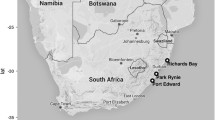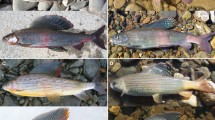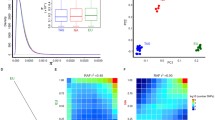Abstract
The congruence between secondary sexual characters and molecular markers, linked to the Ychromosome was examined in Asian populations of five Pacific salmon species of the genus Oncorhynchus. Our results support the existence of discrepancy between secondary sexual characters and sex-linked molecular markers in all species examined, which suggests the existence of similar or identical mechanism responsible for this phenomenon in Pacific salmons. Clinal latitudinal directional variation of the character confirmed the possibility that this phenomenon could be adaptively important, including its importance for regulation of the population number. In addition to natural factors affecting the degree of discrepancy between morphobiological characters and molecular markers in the Pacific salmon populations, anthropogenic factors, in particular intense fishery of certain population or population group, is also important.
Similar content being viewed by others
References
Brykov, Vl.A., Kukhlevsky, A.D., and Podlesnykh, A.V., Incomplete Congruence between Morphobiological Characters and Sex-Specific Molecular Markers in Pacific Salmons: I. Analysis of Discrepancy in Five Species of the Genus Oncorhynchus, Russ. J. Genet., 2010, vol. 46, no. 7, pp. 867–872.
Sambrook, J.F., Fritsch, E.F., and Maniatis, T., Molecular Cloning: A Laboratory Manual, New York: Cold Spring Harbor Lab. Press, 1989, 2nd ed.
Devlin, R.H., Biagi, C.A., and Smailus, D.E., Genetic Mapping of Y-Chromosomal Markers in Pacific Salmon, Genetics, 2001, vol. 111, pp. 43–58.
Zhang, Q., Nakayama, I., Fujiwara, A., et al., Sex Identification by Male-Specific Growth Hormone Pseudogene (GH-ξ) in Oncorhynchus masou Complex and a Related Hybrid, Genetics, 2001, vol. 111, pp. 111–118.
Brunelli, J.P. and Thorgaard, G.H., A New Y-Chromosome-Specific Marker for Pacific Salmon, Trans. Am. Fish. Soc., 2004, vol. 133, pp. 1247–1253.
Altukhov, Yu.P., Geneticheskie protsessy v populyatsiyakh (Genetic Processes in Populations), Moscow: Akademkniga, 2003.
Varnavskaya, N.V., Geneticheskaya differentsiatsiya populyatsii tikhookeanskikh lososei (Genetic Differentiation in Pacific Salmon Populations), Petropavlovsk-Kamchatskii: Izd. KamchatNIRO, 2006.
Nagler, J.J., Bouma, J., Thorgaard, G.H., and Dauble, D.D., High Incidence of a Male-Specific Genetic Marker in the Phenotypic Female Chinook Salmon from the Columbia River, Environ. Health Perspectives, 2001, vol. 109, pp. 67–69.
Williamson, K.S. and May, B., Incidence of Phenotypic Female Chinook Salmon Positive for the Male Y-Chromosome-Specific Marker OtY1 in the Central Valley, California, J. Aquat. Anim. Health, 2002, vol. 14, pp. 176–183.
Chowen, T.R. and Nagler, J.J., Temporal and Spatial Occurrence of Female Chinook Salmon Carrying a Male-Specific Marker in the Columbia River Watershed, Environ. Biol. Fishes, 2004, vol. 697, pp. 427–432.
Williamson, K.S. and May, B., Inheritance Studies Implicate a Genetic Mechanism for Apparent Sex Reversal in Chinook Salmon, Trans. Am. Fish. Soc., 2005, vol. 134, pp. 1253–1261.
Devlin, R.H., Park, L., Sakhrani, D.M., et al., Variation of Chromosome DNA Markers in Chinook Salmon (Oncorhynchus tschawytscha) Populations, Can. J. Fish Aquat. Sci., 2005, vol. 62, pp. 1386–1399.
Williamson, K.S., Phillips, R., and May, B., Characterization of a Chromosomal Rearrangement Responsible for Producing “Apparent” XY-Female Fall-Run Chinook Salmon in California, J. Hered., 2008, vol. 99, pp. 483–490.
Shinomiya, A., Otake, H., Togashi, K., et al., Field Survey of Sex-Reversals in the Medaka, Oryzias latipes: Genotypic Sexing of Wild Populations, Zool. Sci., 2004, vol. 21, pp. 613–619.
Scholz, S., Rosler, S., Schaffer, M., et al., Hormonal Induction and Stability of Monosex Populations in the Medaka (Oryzias latipes): Expression of Sex-Specific Marker Genes, Biol. Reprod., 2003, vol. 69, pp. 673–678.
Otake, H., Shinomiya, A., Matsuda, M., et al., Wild-Derived XY Sex-Reversal Mutants in the Medaka, Oryzias latipes, Genetics, 2006, vol. 173, pp. 2083–2090.
Devlin, R.H. and Nagahama, Y., Sex Determination and Sex Differentiation in Fish: An Overview of Genetic, Physiological, and Environmental Influences, Aquaculture, 2002, vol. 208, pp. 191–364.
Arukwe, A., Cellular and Molecular Responses to Endocrine-Modulators and the Impact on Fish Reproduction, Mar. Pollut. Bull., 2001, vol. 42, no. 8, pp. 643–655.
Craig, J.K., Foote, C.J., and Wood, C.C., Evidence of Temperature-Dependent Sex Determination in Sockeye Salmon (Oncorhynchus nerka), Can. J. Fish. Aquat. Sci., 1996, vol. 138, pp. 141–147.
Pandian, T.J. and Sheela, S.G., Hormonal Induction of Sex Reversal in Fish, Aquaculture, 1995, vol. 138, pp. 1–22.
Pfierrer, F., Endocrine Sex Control Strategies for the Feminization of Teleost Fish, Aquaculture, 2001, vol. 197, pp. 229–281.
Yamazaki, F., Sex Control and Manipulation in Fish, Aquaculture, 1983, vol. 33, pp. 329–354.
Brykov, Vl.A., Kukhlevsky, A.D., Shevlyakov, E.A., et al., Sex Ratio Control in Pink Salmon (Oncorhynchus gorbuscha) and Chum Salmon (O. keta) Populations: The Possible Causes and Mechanisms of Changes in the Sex Ratio, Russ. J. Genet., 2008, vol. 44, no. 7, pp. 786–792.
Cotton, S. and Wedekind, C., Population Consequences of Environmental Sex Reversal, Conservative Biol., 2008, vol. 23, pp. 196–206.
Author information
Authors and Affiliations
Corresponding author
Additional information
Original Russian Text © Vl.A. Brykov, A.D. Kukhlevsky, A.V. Podlesnykh, 2010, published in Genetika, 2010, Vol. 46, No. 11, pp. 1533–1543.
Rights and permissions
About this article
Cite this article
Brykov, V.A., Kukhlevsky, A.D. & Podlesnykh, A.V. Incomplete congruence between morphobiological characters and sex-specific molecular markers in pacific salmons: 2. Population and temporal variability of the phenomenon. Russ J Genet 46, 1352–1361 (2010). https://doi.org/10.1134/S1022795410110116
Received:
Published:
Issue Date:
DOI: https://doi.org/10.1134/S1022795410110116




